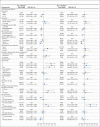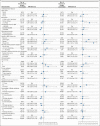Multilevel Factors for Adiposity Change in a Population-Based Prospective Study of Black Breast Cancer Survivors
- PMID: 35333586
- PMCID: PMC9273374
- DOI: 10.1200/JCO.21.02973
Multilevel Factors for Adiposity Change in a Population-Based Prospective Study of Black Breast Cancer Survivors
Abstract
Purpose: Unfavorable weight change after breast cancer diagnosis increases the risk of mortality, but individual and neighborhood risk factors affecting postdiagnosis weight and body fat changes are unclear among Black women, who have higher rates of obesity and mortality than any other racial/ethnic group.
Methods: Adiposity changes during the period approximately 10 months-24 months after diagnosis were evaluated among 785 women diagnosed between 2012 and 2018 and enrolled in the Women's Circle of Health Follow-Up Study, a population-based prospective cohort of Black breast cancer survivors in New Jersey. Multilevel factors for weight and fat mass change (with gain or loss defined as a relative difference of 3% or more, and considering whether changes were intentional or unintentional) were estimated using multivariable polytomous logistic regressions and multilevel models.
Results: Adiposity gain was prevalent: 28% and 47% gained weight and body fat, respectively, despite a high baseline prevalence of overweight or obesity (86%). Risk factors for fat mass gain included receiving chemotherapy (relative risk ratio: 1.59, 95% CI, 1.08 to 2.33) and residing in neighborhoods with a greater density of fast-food restaurants (relative risk ratio comparing highest with lowest tertile: 2.18, 95% CI, 1.38 to 3.46); findings were similar for weight gain. Only 9% of women had intentional weight loss, and multilevel risk factors differed vastly from unintentional loss.
Conclusion: Both individual and neighborhood factors were associated with adiposity change among Black breast cancer survivors. Residential environment characteristics may offer clinically meaningful information to identify cancer survivors at higher risk for unfavorable weight change and to address barriers to postdiagnosis weight management.
Conflict of interest statement
Figures


References
-
- Norat T, Chan D, Vieira AR, et al. : Systematic Review on Diet, Nutrition, Physical Activity and Survival and Second Cancers in Breast Cancer Survivors. World Cancer Research Fund/American Institute for Cancer Research. Continuous Update Project Report, 2014. https://www.wcrf.org/wp-content/uploads/2021/02/breast-cancer-survivors-...
-
- Chlebowski RT, Blackburn GL, Thomson CA, et al. : Dietary fat reduction and breast cancer outcome: Interim efficacy results from the Women's Intervention Nutrition study. J Natl Cancer Inst 98:1767-1776, 2006 - PubMed
-
- Runowicz CD, Leach CR, Henry NL, et al. : American Cancer Society/American Society of Clinical Oncology Breast Cancer Survivorship Care guideline. CA Cancer J Clin 66:43-73, 2016 - PubMed
-
- Pedersen B, Delmar C, Lörincz T, et al. : Investigating changes in weight and body composition among women in adjuvant treatment for breast cancer: A scoping review. Cancer Nurs 42:91-105, 2019 - PubMed
Publication types
MeSH terms
Grants and funding
LinkOut - more resources
Full Text Sources
Medical

